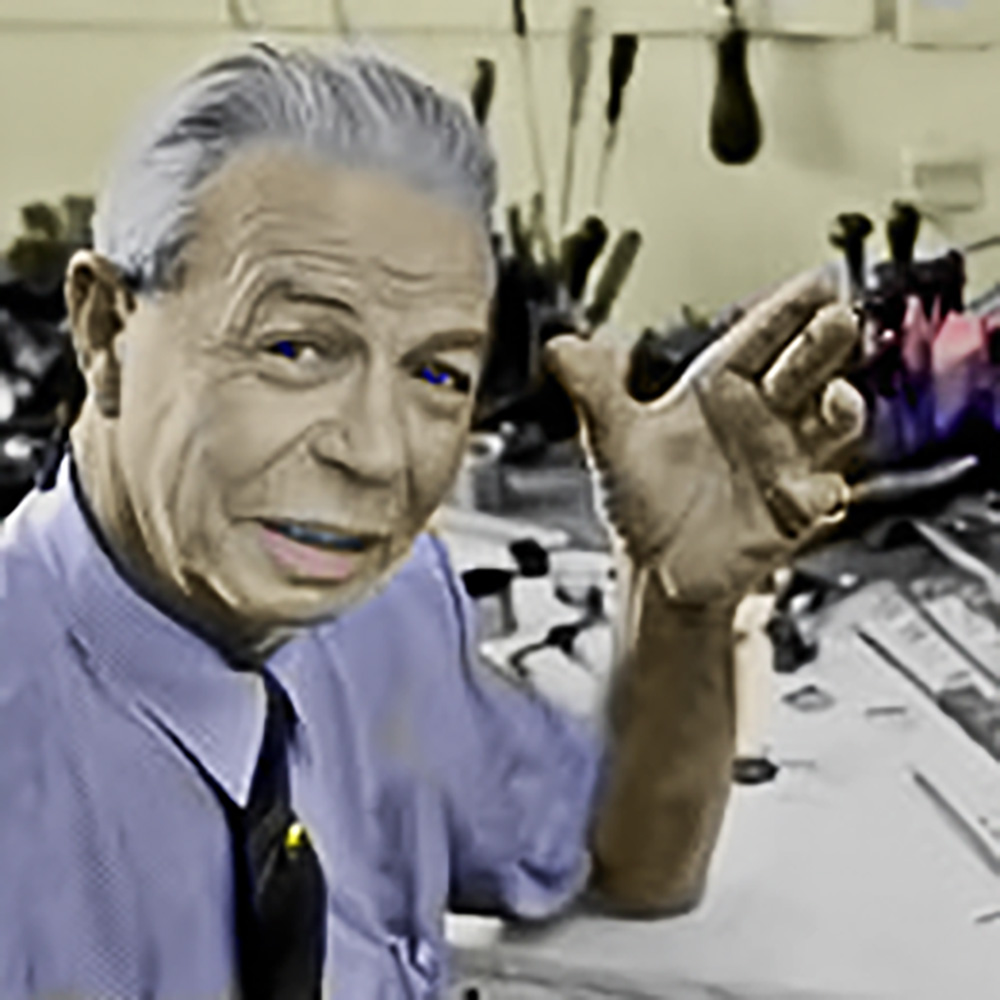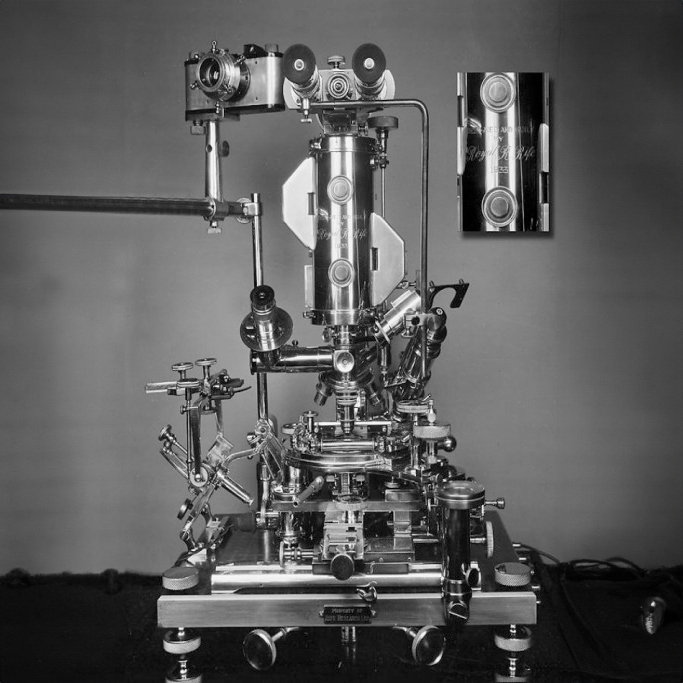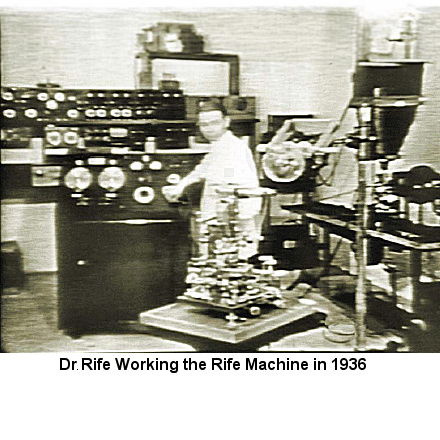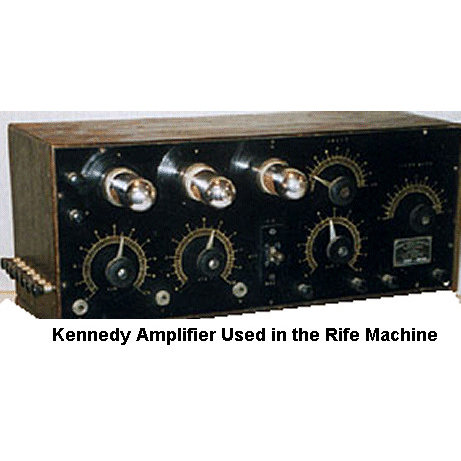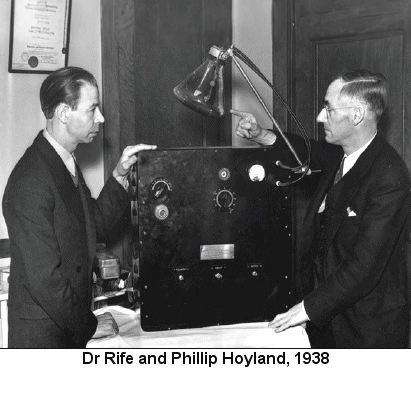
Sometime in early 1936 William Donner, the President of the International Cancer Research Foundation, visited Rife and Johnson. He was impressed by what he saw and wanted his colleagues in Philadelphia to witness a demonstration. Rife agreed to travel east in the spring and show them how to filter a BX cancer virus. Also in early 1936, Johnson and Henry Timken, Rife”s original sponsor, completed agreements to build the wonderful laboratory Rife had so long envisioned. The ground was broken in April and Rife moved in during the latter part of July. Rife and Philip Hoyland began revising the Royal Rife Machine in the early months of 1936, eliminating parts which had been made obsolete by recent advances in electronics. During that summer they produced an entirely new method of generating the desired frequencies. Among the new test appliances they created was a nine inch Cathode-Ray oscillograph of high sensitivity, built for the purpose of photographing the different frequencies on motion picture film. This enabled them to study and classify the numerous waves in an entirely new way. In April Rife traveled to San Francisco to help Dr. Walker get his test procedures refined. On May 1, he left for Chicago where he attended an electronics convention. From there he traveled to Louisville where an eye doctor examined him and restricted his daily use of the microscope to two hours. On May 9, 1936, he arrived in Philadelphia for the fateful meeting with the International Cancer Research Foundation.
What followed belongs in the category of tragic fiascos. In February of the next year, Johnson wrote to Dr. Edward Archibald, Canada”s most renowned cancer specialist and an associate of Dr. Gruner who had collaborated with Rife in the Spring of 1935. Johnson described to Dr. Archibald what Rife encountered in Philadelphia during his May 1936 demonstration: “Rife reported that they provided him with six or seven tumors without any pathological report .whatsoever on any of them. He examined them microscopically and found that all but three had been heavily rayed with X-ray or had been treated with radium. The three which had not been treated, he planted and irradiated in the argon tube in accordance with our technique. In each case, he obtained the characteristic BX. They insisted upon keeping some of the material so obtained and said they were going to try to produce cancers in animals of their own. We have never been notified whether or not they did so.
The atmosphere in which Mr. Rife found himself was one of extreme skepticism. They were urged not to try to reproduce these experiments without first learning our techniques by actual experience, but were determined to go ahead, and if they did so, they probably failed.” On May 22, 1936, William Donner wrote to Johnson and told him no grant would be forthcoming for at least 100 days or so, thereby breaking the promise he had given Johnson and Rife at the beginning of the year. Johnson’s reply on May 27 is an anguished plea for the Foundation to finance Dr. Gruner for a period of time at Rife’s side in San Diego instead of paying an inexperienced clinician in Philadelphia to try replicating Rife’s procedures. The plea fell on deaf ears, but is worth quoting at some length. It exemplifies how one man’s clear thinking (in this case Johnson’s) may be more important in accomplishing a research goal than all the prestige, careful procedures and credentialed expertise that an important foundation can organize.
Johnson wrote: “Your letter came as a great disappointment to me. I had thought from what you told me in the winter, that we might hope for an immediate grant if Mr. Rife was able to show to your man the BX taken from human carcinoma and the method by which the organism was grown. “I understood you to say that you felt so strongly about it that if Mr. Rife were successful, you yourself would be willing to give Dr. Gruner’s services for a year if your Board, which did not believe in the bacterial origin of cancer, was unwilling to make the grant.
“You secured Dr. Dodge who, I agree, is one of the finest mycologists in America. He worked every minute, step by step, with Mr. Rife. Notes were taken of every detail of each day’s work, and these notes were signed daily by both Dr. Dodge and Mr. Rife. This shows how entirely frank Mr. Rife was in showing every minute step of the process to Dr. Dodge. “As this same organism has been repeatedly found by us and also by Dr. Arthur I. Kendall in Chicago, and now in Philadelphia, you and your board can surely assume that if not the sole cause of cancer, it is at least constantly present in that disease. So far as we know, no other research group has gone so far. “A delay until October is almost tragic at this stage of the work. Dr. Gruner has had invitations to go elsewhere, but has waited to see if we could secure the grant to carry on the work, as he believes we are further along than any other research group. “In delaying until October, are you not demanding from us more than from a research organization?”
“We cannot prove these points without further research and we have always understood that the organizations to which you have already given grants are merely research organizations. You say that you are selecting a man in Philadelphia to carry on the inoculating and the growing of the organisms from human cancer during Dr. Dodge’s absence. Perhaps you do not realize that it is impossible to handle filter-passing forms of bacteria without a-microscope which shows them. Only by this means can the work be properly checked from day to day. As you undoubtedly must pay the man whom you select in Philadelphia to do this work, would you not be willing to employ Dr. Gruner yourself to work out here with Mr. Rife and his microscope? He would have every facility and every probability of success. May I remind you that over three years ago, Dr. Arthur I. Kendall of Northwestern Medical School published his epochal work on filter-passing organisms, and that since that time, many, many scientists have tried in vain to repeat his experiments. Such men as Park of New York, and Zinsser of Harvard, having failed in their attempts, have vociferously denied the existence of these filter-passing organisms. You yourself know how mistaken that is.”
“We have found no way to grow these organisms except in the Kendall medium, and even when Kendall medium has been supplied to these other scientists, they have not been able to sterilize the medium without mining it. “It would seem to me, in view of these facts and the peculiar situation in which this matter seems to be involved, that it would be wise to select someone in whom you have every confidence and send him to the Rife Laboratory to work this problem out. Do you not feel that it should be someone who has actually grown filter-passing organisms and can see and recognize them? If you are unwilling to give us Dr. Gruner, will you not send a man whom you have selected here to us? I cannot believe that any man lacking experience in handling filter-passing organisms and without a Rife microscope can succeed in many times the 100 days which you cite as a minimum.”
“You and we are seeking to conquer this horrible human curse. I realize that the general acceptance of our views will completely revolutionize present concepts concerning the causes of many diseases besides cancer. Therefore, the greatest care must be taken in each step if we are to avoid at least some of the tremendous antagonisms which always greet new ideas. For that reason, we are willing to go to extremes in checking our findings and having them checked, but we do not want to be checked by inexperienced men in a matter involving so highly technical and so specialized a knowledge. Hoping you will bear with me and will consider patiently each point which this letter has tried to bring before you, I am Very seriously yours, Milbank Johnson”
On June 2, 1936, William Donner turned down Milbank Johnson’s plea. The International Cancer Research Institute would do their own tests. At the end of December, Mildred Schram wrote to Rife, asking for his advice as they completed their experiments. In October, Donner wrote to Rife. Rife refused to answer them. In November, Donner telegraphed Johnson. Then wrote him again. But Rife had wasted enough time with them. He was curing cancer while the foundation broke their agreements, insisted on procedures with inexperienced people which were doomed from the outset, and ignored the larger goal which Rife was achieving-the cure of cancer in human beings. Sometime in the spring of 1936, Johnson closed his clinic at the Santa Fe Hospital. The results had been impressive, but he wanted to pause because of the improvements being made in the Royal Rife Machine and then open the third clinic in the fall of 1936.
On April 28, 1936, Dr. Harry Goodman, an eye specialist, wrote to Johnson describing the effect of the Royal Rife Machine on Mrs. Julia M. Gowdy . She had been examined previously on March 23. A little more than a month later, her vision had improved 29% in one eye and 10% in the other. “It had been difficult for her to read the telephone book but now she gets the numbers rather quickly,” Goodman reported. In December, Dr. James Couche of San Diego, who had witnessed the first cancer clinic at the Scripps Ranch in 1934, began conducting a clinic with the help of Jack Free, Rife’s assistant. They treated cancer and senile cataracts. While the records are incomplete, the first three were cancer patients and according to Couche’s notes, all completely recovered. Also in December, Dr. Milbank Johnson opened his third clinic in the Pasadena Home for the Aged. The clinic lasted until May 1937. Johnson’s description of his success and the incredible medical events he was witnessing were preserved in copies of letters he sent to Dr. Gruner in Canada and to Dr. Meyer in San Francisco just before the year ended.
To Gruner, Johnson wrote, “The clinic is held three mornings a week, Tuesday, Thursday and Saturday. Yesterday I had eighteen patients. Among them were two cases of pulmonary tuberculosis, three cases of carcinoma, two cases of chronic varicose ulcers of the leg, and sundry other cases of more or less definite infection origin. . . . I certainly wish you were here to work with me because I am afraid that even you, who know what we are trying to do, will not believe some of the yarns that I would have to tell you as to what is occurring in that clinic without actually seeing them yourself.”
To Dr. Meyer, Johnson reported: “At times the results of the Royal Rife Machine are absolutely astounding, causing an instantaneous sterilization of the wounds, whether interior or exterior.” The Special Medical Research Committee was still in charge however and they were keeping a tight clamp on any announcement until the procedures were certain. In April 1936, prior to Rife’s Philadelphia visit, Johnson had specifically instructed Donner that everything the foundation witnessed was to be held in strict confidence. Johnson insisted that “there should be no publication nor any kind of publicity attending this demonstration without the consent of the Special Medical Research Committee of the University of Southern California. We are doing this to prevent any premature publication and the raising of false hopes before things have been thoroughly proven.”
In early December, Johnson wrote to Meyers asking when he could be in Los Angeles in order that Johnson could schedule a meeting of the Committee. There was much to report. And then, ten days before Christmas, Johnson and Rife got a Christmas present from San Francisco. Dr. E. L. Walker, Meyer’s coworker at the Hooper Foundation, had (on his own, independent of Rife) isolated in June 1936 the fungus form of cancer – crytomyces pleomorphia. In December, he announced he had isolated from a cancer breast the virus form – “motile colored bodies under the Rife microscope, presumably your BX.”
